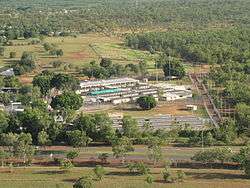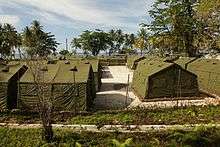Australian immigration detention facilities
Australian immigration detention facilities comprise a number of different facilities throughout Australia (including one on the Australian territory of Christmas Island).[1] They are currently used to imprison people who are detained under Australia's policy of mandatory immigration detention, and previously under the now defunct Pacific Solution.[2] The facilities are currently operated by Serco, and were previously run under G4S who used to be named Global Solutions Limited (GSL), under contract from the Department of Immigration and Border Protection (DIBP).[3][4][5]
The facilities' existence has been condemned on human rights grounds and have even been likened to concentration camps by some critics.[6][7]
Background
The Migration Act 1958 allowed discretionary detention of unauthorised arrivals until 1992. Since the 1990s when the Keating Government created a policy of mandatory detention of unauthorised arrivals, with non-citizens arriving by boat without a valid visa being detained until they were either granted a visa, or deported.[8]
Towards the end of the 1990s, a large increase in the number of unauthorised arrivals exceeded the capacity of the existing Immigration Reception and Processing Centres at Port Hedland and Curtin.[9]
Facilities and citizenship
Immigration Detention Centres (IDCs)


Immigration detention centres detain people who have overstayed their visa, breached their visa conditions and had their visa cancelled or have been refused entry at Australia's entry ports.[10] This includes irregular maritime arrivals claiming asylum without passports, identity papers or valid entry visas. Under the Migration Act 1958, people arriving in this manner are classed as unlawful non-citizens and are currently subject to mandatory detention. However, in 1954 the Australian government ratified the United Nations Convention Relating to the Status of Refugees. Under Article 31 of the convention, the Australian government is legally obligated to grant anyone fleeing persecution and seeking asylum the right to enter the country by whatever means possible. Furthermore, the Article states that signatory countries are not to impose penalties on or indefinitely restrict the freedom of movement of those seeking asylum.[11]
Australia's Migration Act 1958 requires people who are not Australian citizens and who are unlawfully in Australia to be detained. Unless they are given legal permission to remain in Australia by being granted a visa, unlawful non-citizens must be removed from Australia as soon as reasonably practicable. The Australian government claims that immigration detention is not used to punish people. Instead, they claim it is an administrative function whereby people who do not have a valid visa are detained while their claims to stay are considered or their removal is facilitated.[12]
There are, or were, centres located at:
- Maribyrnong, established at Melbourne in 1966.
- Villawood, established at Sydney in 1976.
- Perth, established in 1981.
- Christmas Island, established 2001.
- Northern, established at Darwin in 2001.
- Baxter, near Port Augusta, SA, established 2002, closed 2007.
- Wickham Point, established at Darwin in 2011.
- Curtin, near Derby, WA, reopened in 2010.
- Scherger, near Weipa, Queensland, opened 2010, closed 2014.[13]
- Yongah Hill, near Northam, WA, established in 2012.
Immigration Residential Housing Centres (IRHC)
Immigration residential housing provides an option for accommodating people in independent family-style housing in a community setting while still formally being detained. This type of facility is one of several types of alternative residential accommodation for detained people, subject to them meeting eligibility criteria.[14]
- Perth
- Sydney
- Port Augusta
Immigration Transit Accommodation Centres (ITAC)
The Brisbane Immigration Transit Accommodation opened in November 2007 and the Melbourne Immigration Transit Accommodation opened in June 2008. Further immigration transit accommodation opened in Adelaide in 2011. ITCs are for short-term, low-risk detainees.[5]
- Brisbane
- Melbourne
- Adelaide
Alternative Places of Detention (APOD)
Alternative Places of Detention (APOD) can accommodate any person who is in immigration detention. APOD may range from hospital accommodation in cases of necessary medical treatment, schools for the purpose of facilitating education to school-aged minors, rented accommodation in the community (hotel rooms, apartments), or accommodation in the community made available through arrangements with other government departments.
- Darwin
- Inverbrackie
- Leonora
- Christmas Island
Pacific Solution facilities

Since the implementation of the Pacific Solution Australia also funded immigration detention centres on:
- Manus Regional Processing Centre, Papua New Guinea closed in February 2008, re-opened on 22 November 2012 (re-closed on 23 November 2017).[15]
- Nauru Regional Processing Centre closed in February 2008, re-opened in 2012.[16]
Controversy
The facilities have been a source of much controversy during their time of operation. There have been a number of riots and escapes,[17] as well as accusations of human rights abuses from organisations such as refugee advocates, Amnesty International, the Australian Human Rights and Equal Opportunity Commission, Human Rights Watch, and the United Nations. Journalists are forbidden from entering the detention centres.[18]
In January 2014, the Australian Labor Party and the Australian Greens accused the government of a cover-up over a violent clash on 18 October 2013 at the Manus Island facility between the Papua New Guinea army and the Papua New Guinea police mobile squad hired for the facility's security, leading to Australian expatriate staff being evacuated, while local staff and asylum seekers remained.[19] On 5 May 2014, it was reported that several Salvation Army staffers had alleged that refugees were regularly subjected to beatings, racist slurs, and sexual assaults within the facility.[20]
In March 2002, Irene Khan, the Secretary General of Amnesty International, said:
It is obvious that the prolonged periods of detention, characterised by frustration and insecurity, are doing further damage to individuals who have fled grave human rights abuses. The detention policy has failed as a deterrent and succeeded only as punishment.
How much longer will children and their families be punished for seeking safety from persecution?[21]
Former Prime Minister John Howard and successive immigration ministers maintained that their actions were justified in the interests of protecting Australia's borders and ensuring that immigration law was enforced.
Refugee "Swap" with the US
In 2016 the Australian government announced an intention to exchange some proven refugees from either Nauru and/or Manus Island for certain displaced people presently in Central America as part of an agreement with the Obama administration of the United States.
In early 2017 Prime Minister Malcolm Turnbull announced that he was confident the agreement would proceed, despite the change of President to Donald Trump. However, latest information appears to cast doubt on the willingness of the US government to honour any such agreement, especially in light of Trump's executive order suspending entry to the US from several countries.[22]
On 2 February 2017 Australian news outlets, quoting the Washington Post, reported that a telephone conversation between Trump and Turnbull had been acrimonious in relation to the "swap", and that Trump had terminated the call ahead of time.[23] Trump has expressed admiration over the detention facilities, opining that the US should do the same.[24]
See also
References
- ↑ "Australia". Immi.gov.au. Retrieved 2013-12-01.
- ↑ Jaffa McKenzie; Reza Hasmath (2013). "Deterring the 'Boat People': Explaining the Australian Government's People Swap Response to Asylum Seekers". Australian Journal of Political Science. SSRN. 48 (4): 417–430. doi:10.2139/ssrn.2247142. SSRN 2247142.
- ↑ "GSL (Australia)". Detention Services Contract. Archived from the original on 29 August 2007. Retrieved 23 October 2007.
- ↑ "Welcome to DIBP". Immi.gov.au. 17 September 2009. Archived from the original on 24 February 2005. Retrieved 2013-12-01.
- 1 2 "About the facilities". Immi.gov.au. Retrieved 2013-12-01.
- ↑ Charles, Stephen (4 May 2016). "Our detention centres are concentration camps and must be closed". Australia – via The Sydney Morning Herald.
- ↑ https://www.nbcnews.com/news/world/australia-houses-migrants-degrading-offshore-detention-camps-n715761
- ↑ Archived 29 July 2009 at the Wayback Machine.
- ↑ "Report" (PDF). Australia: Commonwealth of Australia. 2008. Retrieved 10 August 2008.
- ↑ "Fact Sheet 82 - Immigration Detention". Immi.gov.au. Retrieved 2013-12-01.
- ↑ "The Refugee Convention - Article 31: Refugees unlawfully in the country of refuge". Archived from the original on 20 March 2014.
- ↑ "About immigration detention". Immi.gov.au. Retrieved 2013-12-01.
- ↑ Ireland, Judith (14 January 2014). "Scott Morrison announces closure of four immigration detention centres". Sydney Morning Herald. AAP. Retrieved 30 July 2015.
- ↑ "About the facilities". Immi.gov.au. Retrieved 2013-12-01.
- ↑ "First Asylum Seekers Sent to Manus Island". Theaustralian.com.au. Retrieved 2013-12-01.
- ↑ "Troops ready to reopen detention centres on Nauru and Manus Island". Theaustralian.com.au. Retrieved 2013-12-01.
- ↑ "ASIA-PACIFIC | Australia's asylum policy". BBC News. 2001-08-31. Retrieved 2013-12-01.
- ↑ "Lack of media access into detention centres is shaping the asylum seeker conversation in Australia". www.ibtimes.com.au.
- ↑ "Cover-up of violent PNG police-army clash on Manus". smh.com.au. Retrieved 2014-01-05.
- ↑ "Ex-Manus Island workers report beatings, rapes of asylum seekers". Sydney Morning Herald. 2014-05-06. Retrieved 2014-05-06.
- ↑ "Secretary General Irene Khan to respond to Woomera Incidents" (Press release). Amnesty International. 8 March 2002. Retrieved 2007-01-13.
- ↑ "Australia will be expected to 'reciprocate' eventually".
- ↑ "Trump 'blasts, hangs up on Turnbull'".
- ↑ "Trump urged Mexican president to end his public defiance on border wa…". 3 August 2017. Archived from the original on 3 August 2017.
External links
| Wikimedia Commons has media related to Australian immigration detention facilities. |